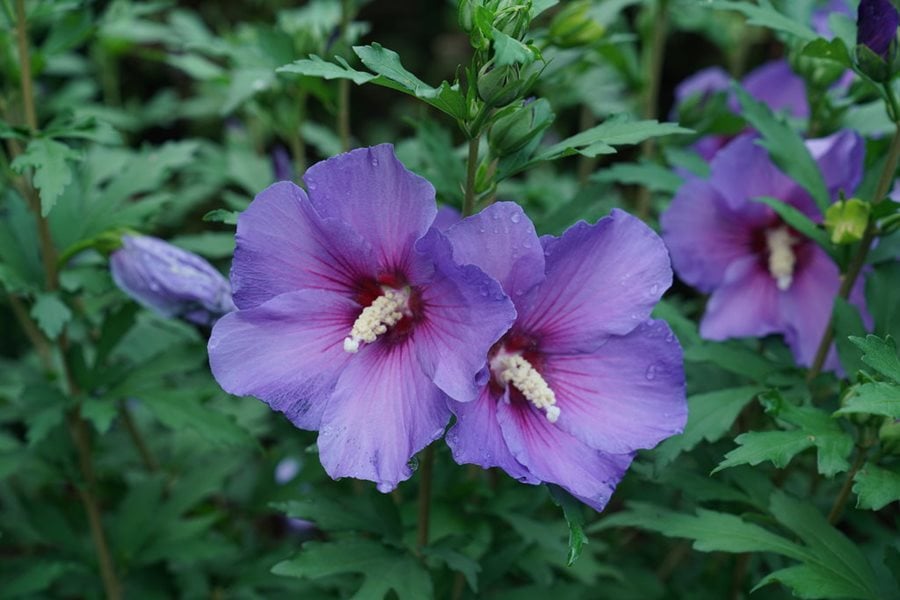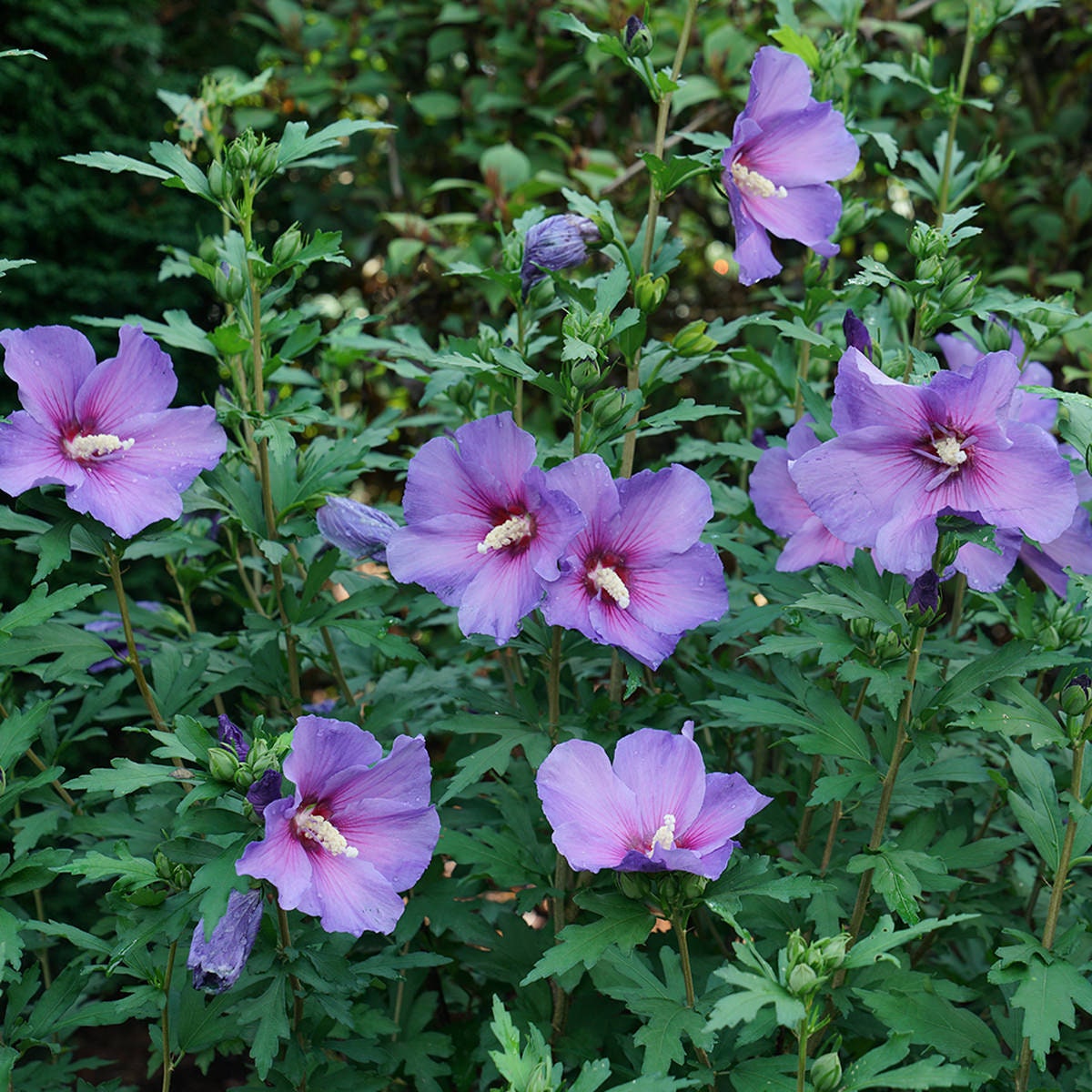Purple Reign: The Stunning Beauty Of The Purple Rose Of Sharon
The purple rose of Sharon is a beautiful flowering shrub that is native to Asia. It is also known as the hibiscus syriacus, and it is a member of the mallow family. The purple rose of Sharon is known for its stunning purple flowers, which can bloom from late spring to early fall. The flowers are typically 3-4 inches in diameter, and they have a slightly cupped shape. The petals are soft and velvety, and they can range in color from deep purple to lavender.
In addition to its beautiful flowers, the purple rose of Sharon is also a relatively easy plant to care for. It is drought-tolerant and heat-tolerant, and it can thrive in a variety of soil conditions. The purple rose of Sharon is also a relatively pest- and disease-resistant plant.
If you are looking for a beautiful and easy-care flowering shrub, the purple rose of Sharon is a great option. It is a versatile plant that can be used in a variety of settings, including gardens, patios, and containers.
Main Content
History and Origin
The purple rose of Sharon is native to Asia, and it has been cultivated for centuries. The plant was first introduced to Europe in the 16th century, and it quickly became popular as an ornamental plant. The purple rose of Sharon was introduced to North America in the 17th century, and it has been a popular garden plant ever since.
Different Types of Purple Rose of Sharon
There are many different varieties of purple rose of Sharon, each with its own unique characteristics. Some of the most popular varieties include:
- ‘Excelsior’: This variety has large, deep purple flowers.
- ‘Lady in Waiting’: This variety has lavender flowers with a white center.
- ‘Snow Queen’: This variety has white flowers with a pink blush.
- ‘Pink Chiffon’: This variety has pink flowers with a white center.
- ‘Oriental Dream’: This variety has large, deep purple flowers with a white center.
Care and Maintenance
The purple rose of Sharon is a relatively easy plant to care for. It is drought-tolerant and heat-tolerant, and it can thrive in a variety of soil conditions. The purple rose of Sharon is also a relatively pest- and disease-resistant plant.
However, there are a few things to keep in mind when caring for the purple rose of Sharon. The plant prefers full sun, but it can also tolerate partial shade. The purple rose of Sharon should be watered regularly, but it is important to avoid overwatering. The plant should be fertilized once a year in the spring.
Pests and Diseases
The purple rose of Sharon is a relatively pest- and disease-resistant plant. However, it can be susceptible to a few pests, such as aphids, spider mites, and scale. The plant can also be susceptible to a few diseases, such as powdery mildew and rust.
If you notice any pests or diseases on your purple rose of Sharon, you can treat them with insecticidal soap or neem oil. You can also prevent pests and diseases by regularly inspecting your plant and removing any infected leaves or branches.
Propagation
The purple rose of Sharon can be propagated by seed, cuttings, or division. Seed propagation is the most common method, but it can be time-consuming. Cutting propagation is a faster method, but it is more difficult. Division is the easiest method, but it is only possible if you have an established plant.
Uses
The purple rose of Sharon is a versatile plant that can be used in a variety of settings. It is a popular garden plant, and it can also be used in containers. The purple rose of Sharon is also a popular cut flower, and it can be used in bouquets and arrangements.
Conclusion
The purple rose of Sharon is a beautiful and easy-care flowering shrub that is a great addition to any garden. It is a versatile plant that can be used in a variety of settings, and it is a popular choice for cut flowers. If you are looking for a beautiful and easy-care flowering shrub, the purple rose of Sharon is a great option.
The purple rose of Sharon is a beautiful and versatile plant that can add a touch of elegance to any garden. These shrubs or trees can grow up to 15 feet tall, and their flowers come in a variety of colors, including purple, pink, white, and red. Purple rose of Sharons bloom from summer to fall, and they are a popular choice for hedges, borders, and specimen plantings.
If you are interested in learning more about purple rose of Sharons, I recommend visiting the Garden Wiki. This website has a wealth of information about the plant, including its history, care requirements, and varieties. You can also find photos and videos of purple rose of Sharons in bloom.
FAQ of purple rose of sharon
Question 1: What is a purple rose of Sharon?
Answer: A purple rose of Sharon is a type of flowering shrub that is native to Asia. It is known for its large, showy blooms that come in a variety of colors, including purple, pink, white, and blue. Purple rose of Sharon is a popular ornamental plant that is grown in gardens and landscapes around the world.
Question 2: How do I care for a purple rose of Sharon?
Answer: Purple rose of Sharon is a relatively easy plant to care for. It prefers full sun but can tolerate partial shade. It is drought-tolerant once established, but it does need regular watering during its first year of growth. Purple rose of Sharon is not fussy about soil type, but it does best in well-drained soil. You can fertilize your purple rose of Sharon in the spring with a balanced fertilizer.
Question 3: How long does it take for a purple rose of Sharon to grow?
Answer: Purple rose of Sharon grows at a medium rate, with height increases of 13–24" per year. It can reach a mature height of 6–12 feet.
Question 4: What are some common pests and diseases that affect purple rose of Sharon?
Answer: The most common pests that affect purple rose of Sharon are aphids, scale insects, and spider mites. These pests can be controlled with insecticidal soap or neem oil. The most common diseases that affect purple rose of Sharon are powdery mildew and leaf spot. These diseases can be prevented by watering your plant properly and by providing good air circulation.
Question 5: How do I propagate a purple rose of Sharon?
Answer: Purple rose of Sharon can be propagated by seed, cuttings, or layering. Seed propagation is the most common method, but it can be slow and unpredictable. Cutting propagation is a more reliable method, but it requires rooting hormone. Layering is a relatively easy method that produces plants that are genetically identical to the parent plant.
Image of purple rose of sharon
5 different images of "purple rose of sharon" from Pinterest:
- A close-up of a single purple rose of Sharon flower. The flower is a deep purple color with a white center. It has a large, trumpet-shaped bloom.

- A cluster of purple rose of Sharon flowers. The flowers are a variety of shades of purple, from light lavender to deep plum. They are arranged in a loose cluster on a long stem.

- A purple rose of Sharon bush in full bloom. The bush is covered in large, trumpet-shaped flowers of a deep purple color. The flowers are arranged in clusters along the branches.

- A purple rose of Sharon bush in the fall. The leaves of the bush have turned a beautiful shade of orange, and the flowers are still in bloom. The flowers are a deep purple color, and they contrast beautifully with the orange leaves.

- A purple rose of Sharon bush in a garden. The bush is surrounded by other flowers, including white hydrangeas, yellow daylilies, and blue salvia. The purple rose of Sharon bush adds a touch of elegance to the garden.

Post a Comment for "Purple Reign: The Stunning Beauty Of The Purple Rose Of Sharon"